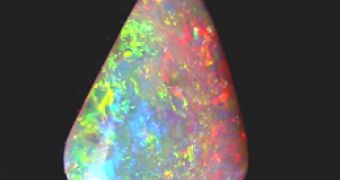The market for computer and home entertainment displays is always looking for higher definitions, less energy consumption, easier setup and better overall image quality. Well, a Canadian research team may have the answer to all the problems encountered by the display industry so far, as their display prototype brings a radical new idea and design.
Unlike conventional displays, this prototype has its pixels made of photonic crystals that are very similar in structure with the gemstone opal as each crystal is made of silica microspheres in a repeating 3D pattern which blocks certain wavelengths of light, or colors, while reflecting others, hence the different colors that can be assumed by the crystal by simply changing the spacing between microspheres. Another good point of this display technology is that is can reach even in the light spectrum that is normally invisible for the human eye and that with out the expensive filters that are in use today. And maybe the most important factor is that as the entire display uses only the ambient light, it has no need of an additional power source for LED or OLED or even lamp backlight illumination.
"They can be viewed just as well in bright sunlight as in indoor light," team member Andr? Arsenault of the University of Toronto told a newspaper referring to the objects displayed on the prototype screen. The crystals that make up the active part of the display are stretched by the passing of an electric current through an electroactive polymer that act as a support layer, so by increasing the voltage that is being applied, the whole spectrum can be spanned.
According to this news site, the crystals could be used in many applications like electronic paper, small displays and road side signs. "This is certainly important work," says photonic physicist Yadong Ying of the University of California, Riverside, US. "Although the principle of tuning the photonic property by changing the lattice spacing is widely known, this system represents the first practical photonic-crystal-based display that has fully electrically tuneable colours."

 14 DAY TRIAL //
14 DAY TRIAL //